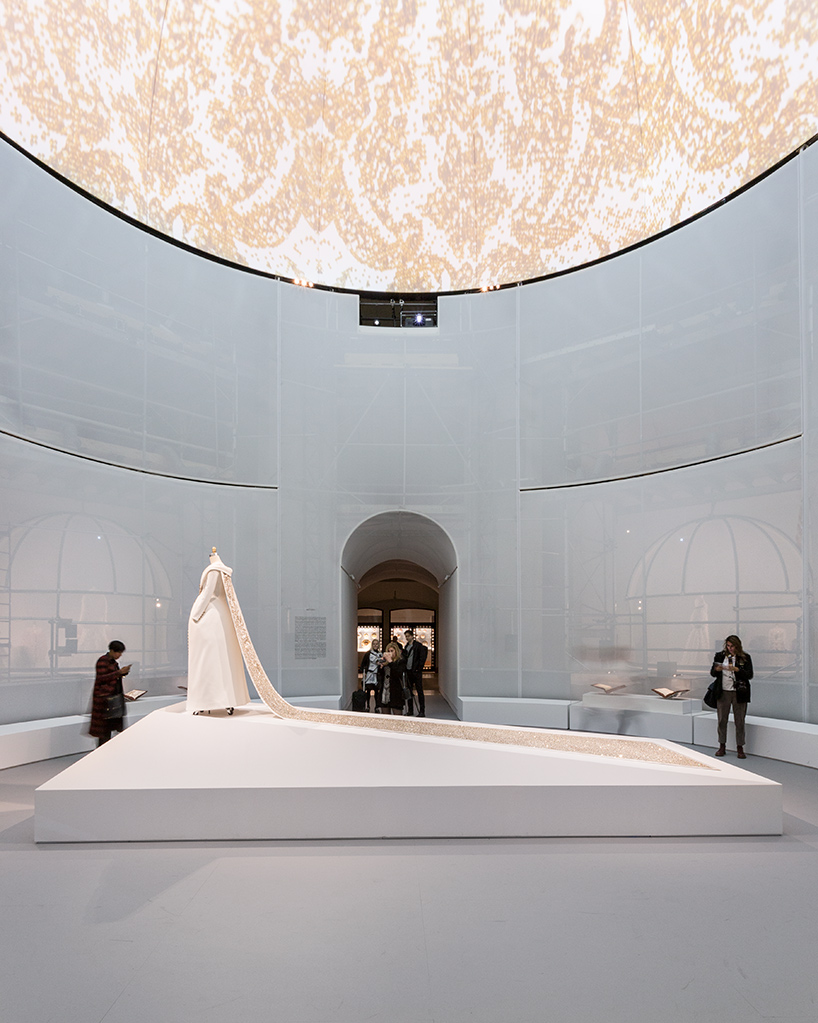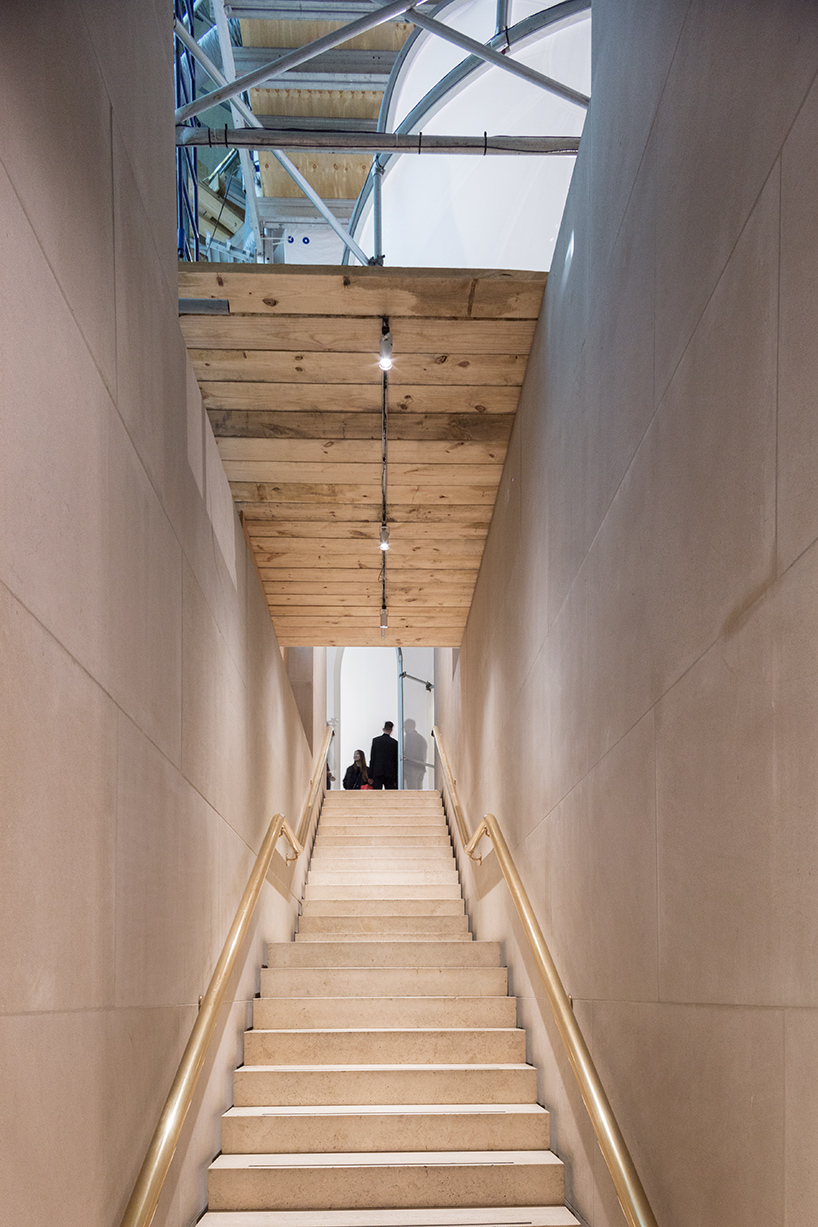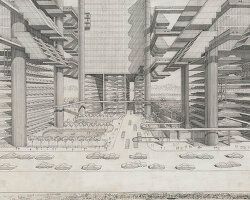
for ‘manus x machina’ — the 2016 edition of the met’s annually staged fashion exhibition — more than 170 garments are presented in order to challenge preconceived notions about hand and machine-made clothing. these haute couture and ready-to-wear items have been grouped into distinct categories and are presented within a series of pochés — temporary alcoves that form part of an immersive ‘ghost cathedral’ designed by OMA new york and its principal shohei shigematsu. alongside the met’s design department, OMA has transformed the atrium of the museum’s robert lehman wing into an almost ethereal space using a perforated white scrim that offers varying degrees of transparency. the dual level intervention hosts a sequence of case studies, where haute couture and ready-to-wear pieces are presented side by side in order to reveal their hand or machine-made characteristics.

a perforated white scrim offers varying degrees of transparency
image by albert vecerka (also main image)
the centerpiece of the exhibition is a 2014 haute couture wedding dress with a 20-foot train, designed by karl lagerfeld for chanel. details of its embroidery are projected onto a domed ceiling, while the floor below is a temporary surface designed by shigematsu and his team to increase potential display area. the first floor unfolds as a series of alcoves built around the architecture of the gallery, while the level below is arranged as sequential suite of rooms presented one after the other. throughout, traditional techniques are presented alongside innovative technologies such as 3D-printing, computer modeling, and ultrasonic welding.
to understand more about the project, designboom spoke with director of OMA new york shohei shigematsu, who led the exhibition’s design. read the interview in full below, and see designboom’s previous coverage of ‘manus x machina’ here.

a haute couture wedding dress by karl lagerfeld forms the centerpiece of the exhibition
image by brett beyer
designboom: how did you interpret the brief from the met, and what did you want to achieve with the exhibition?
shohei shigematsu: the brief was intriguing and we thought it was relevant for all the design world — including architecture — how technology, craft, and the handmade can actually start to collaborate. one thing that inspired me the most is the diversity of the garments and techniques. typically this kind of fashion exhibition has a theme — either bound by a single designer or culture — that has a certain level of coherence. here, it is really about a difference and a diversity. I thought we should really let people focus on the detail, and observing the different techniques. my first idea was to create an environment without seams, with no sense of space — like you were in a cloud — so you could really focus on the garments themselves.

OMA has transformed the previously existing atrium using a temporary floor
image by brett beyer
DB: what are the key aspects of your design?
SS: it is an interesting scale of temporality because the exhibition is not a display, but really an environment design. a given condition was the atrium and the hallway, so we immediately thought that it is not about designing pedestals and projections, but more about creating an integrated environment — simultaneously blocking the natural light, which is not compatible with the garments. we also made a clear circulation path, creating a kind of centrality to the exhibition — the floor didn’t previously exist. all of these things have a sense of temporality that doesn’t really exist in the met, so I think in that regard it is quite successful.

an abstracted version of the dress’s pattern is projected onto the domed ceiling
image by brett beyer
DB: you have referred the installation as a ‘ghost cathedral’. can you expand on the perforated material that you have used to transform the atrium?
SS: it’s a PVC scrim, which is often used for theater sets. it can have an amazing range of transparencies through different light conditions. if you project a light from the front it becomes very opaque, and in oblique angles it is very opaque. but, if you shine a light from the back, it becomes very transparent. so you start to see the depth. my original intent was to see the armature and this sense of temporality. there is an eclectic architectural language, and I thought it could be nice to obsessively cover it, but at the same time leave a sense of the existing language and structure. it is really about creating a fresh sense of temporality within a very old, heavy, and grand institution.

the first floor unfolds as a series of alcoves built around the architecture of the gallery
image by brett beyer
DB: the exhibition is sponsored by apple. were you cautious about incorporating too much media or technology within the design?
SS: after we got the commission, we looked at other fashion shows, and recent costume institute exhibitions. somehow, I always felt that there was an abundance or over usage of media. flat screens becoming bigger and bigger, and higher and higher in resolution. I always thought that it actually takes away from the garments themselves, because you tend to look at the media. you skew your understanding through the media, but you never really confront the garment in detail. I thought that if we were to use media it should be really integrated to the space. it is apple-sponsored, so I’m sure everyone was looking for more technology in the displays, but I thought that would be a little bit too easy.

in total, more than 170 individual garments are presented
image by albert vecerka
DB: the exhibition conveys the message that whether items are hand or machine-made, there needs to be a focus on craftsmanship and quality. how does this theme correspond with contemporary architecture, where a lot of projects seem to be built very quickly and without this attention to detail?
SS: I think that the traditional notion of craftsmanship might be difficult to come back as it used to be, because today’s labor intensity and speed is completely different. but, like fashion, it is not a binary condition anymore — you can actually use machines, but with a notion of craft. in fashion you can print everything, but in architecture you still can’t. I think there is still a sense of craft that technology still cannot cover in architecture. I think there is more room in architecture to actually rethink this potential.

a series of pochés form part of the immersive ‘ghost cathedral’
image by albert vecerka
DB: OMA has a long tradition of working with fashion, with prada in particular. how do you view the relationship between architecture and fashion, and what can both domains learn from one another?
SS: I think, and I hope, it will reach a new level of collaboration. it started with architects designing flagship stores, and I think OMA pushed the boundary with prada to do fashion shows and other things like websites and lookbooks. when I look at this kind of exhibition, it really encourages me to push the collaboration further. it is not just architects making architecture, but both domains can contribute in more direct ways.

haute couture and ready-to-wear items are grouped into distinct categories
image by albert vecerka

the split level intervention hosts a sequence of case studies
image by brett beyer

the PVC scrim is also used at the exhibition’s lower level
image by brett beyer

traditional techniques are presented alongside innovative technologies such as 3D-printing
image by albert vecerka

the entrance to the exhibition, which remains on display until august 14, 2016
image by albert vecerka

shohei shigematsu with exhibition curator andrew bolton
image by albert vecerka







































